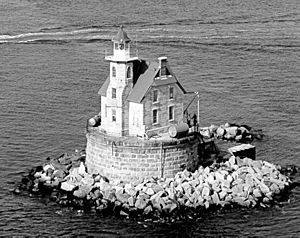Race Rock Light facts for kids
 |
|
| Race Rock light | |
|
|
|
| Location | Entrance to Long Island sound |
|---|---|
| Coordinates | 41°14′36.6″N 72°2′49.2″W / 41.243500°N 72.047000°W |
| Year first constructed | 1878 |
| Year first lit | 1879 |
| Automated | 1978 |
| Deactivated | Active |
| Foundation | Granite and concrete caisson and pier. |
| Construction | Granite |
| Tower shape | Square/octagonal |
| Markings / pattern | Natural color with white lantern |
| Height | 45 feet (14 m) |
| Focal height | 67 feet (20 m) |
| Original lens | Forth order Fresnel lens |
| Range | 16 nautical miles (30 km; 18 mi) |
| Characteristic | Flashing Red 10s |
| Fog signal | Fog Horn points southeast. HORN: 2 every 30s |
| Admiralty number | J0686 |
| ARLHS number | USA-681 |
| USCG number | 1-19815 |
The Race Rock Light is a famous lighthouse. It stands on Race Rock Reef, a group of dangerous rocks in Long Island Sound. This spot is southwest of Fishers Island, New York. Many ships crashed here in the past. Today, the New London Maritime Society takes care of the lighthouse. They do this as part of a special program to save historic lighthouses.
The Race Rock Light was built between 1871 and 1878. A designer named Francis Hopkinson Smith created it. It's a great example of building and design from the 1800s. The huge stone base on the reef took seven years to finish. But the rest of the lighthouse, including the tower, was built in just nine months. The tower has a special Fresnel lens inside. This lens helps the light shine brightly. The light is about 67 feet (20 m) above the water. The United States Coast Guard made the light work automatically in 1978. This meant no one had to live there anymore to turn it on and off.
Contents
Why Race Rock Light Was Needed
Race Rock Lighthouse is in Long Island Sound. It is about 8 miles (13 km) from New London, Connecticut. This area is called "the Race." Here, the water moves very fast and strongly. This made it a dangerous place for ships. By 1837, eight ships had been lost on Race Point reef in just eight years.
In 1838, the government set aside $3,000 for a lighthouse here. But the money was never used. In 1852, the Lighthouse Board said it was hard to mark this spot. Buoys would not stay in place. Other markers would break when the ice melted in spring. A strong, permanent lighthouse was clearly needed.
Building the Lighthouse
Work on the lighthouse's base started in April 1871. This base is called a riprap foundation. Workers used 10,000 tons of granite stones for the foundation. Building it was very expensive. In 1872, the Board said they could only afford the first parts of the foundation. In 1873, Congress gave another $75,000. The lighthouse was finally finished. The total cost was $278,716.
The rocks where the lighthouse stands are under water. They are about three-quarters of a mile from Race Point Reef. Workers first made the underwater area flat with small stones. Then, they placed a round, stepped concrete base. This base was 9 feet (2.7 m) thick. It was made in four layers. Iron bands helped shape the concrete layers. The top of the concrete base is about 8 inches (200 mm) above the water when the tide is low.
On top of the concrete base, a cone-shaped pier was built. This pier is 30 feet (9.1 m) tall. It is 57 feet (17 m) wide at the bottom. The top of the pier is 55 feet (17 m) wide. The pier is made of heavy stone with concrete inside. It also holds water tanks and storage rooms.
Lighthouse Structure and Light
On top of the pier is a stone building. This building has one and a half stories. The granite light tower rises from the front of this building. Large stones called riprap surround and protect the entire structure. The tower is square at the bottom. It becomes eight-sided at the top.
The tower holds a fourth-order electric light. This light flashes red every 10 seconds. It stands 67 feet (20 m) above sea level. From the land, it is 45 feet (14 m) tall. The light can be seen from ships up to 14 nautical miles (26 km; 16 mi) away. There is also a fog horn. It sounds two times every 30 seconds and points southeast.
Protecting a Historic Landmark
Race Rock Light Station was added to the National Register of Historic Places in 2005. This means it is an important historical site. In June 2011, the government offered the lighthouse to groups who would take care of it. This was part of the National Historic Lighthouse Preservation Act. The New London Maritime Society took ownership of Race Rock. They also took over two other lighthouses near New London, Connecticut.
See also
 In Spanish: Race Rock Light para niños
In Spanish: Race Rock Light para niños


